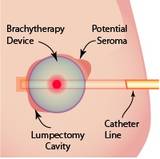Troubled at the sight of the tumor-like swelling on your skin? You may be having a Seroma, a collection of lymph tissues. Go through our article on Seroma to know more about this unique medical condition.
Seroma Definition
Page Contents
Medical practitioners generally define Seroma as a post-injury or post-operative condition. The condition is characterized by a bump or swelling formed by a deposit of lymph, that usually arises after a trauma or a surgical operation. The Seroma lumps are filled with a yellowish or white fluid that can be seen around fresh cuts and blisters.
Seromas are generally an after-effect of an injury to the body or some other condition. They are not a threatening condition by themselves, even though they require proper medical care for their treatment.
Causes of Seroma
A lot of factors can give rise to Seroma formation. These include:
Mastectomy
Mastectomy or surgical breast removal often leads to this abnormality. The operation is usually carried out to get rid of a malignant tumor in the breast. Seroma after breast surgery happens if the blood vessels of an area near the operated region accidentally suffer damage during surgery. The rupture of the blood cells gives rise to an inflammatory response in the body which releases blood plasma. The blood plasma is a colorless watery liquid of the blood. It usually suspends blood cells like leukocytes, thrombocytes and erythrocytes. This fluid, also known as serous liquid as it contains serum produced by the serous membranes of the body, gets accumulated as lumps under the skin. Seroma after mastectomy is a common condition.
Abdominal Surgery
Many people suffer from Seroma after tummy tuck operation or any other major surgery in the abdomen. This arises if the operated area is not properly treated with antiseptics and sutures. If experienced hands are not involved in performing operation for tummy tuck Seroma may occur.
Plastic Surgery
Seromas may also be seen after an imperfectly conducted plastic surgery on the face. Seromas are usually seen to arise in the neck after facial surgeries. Postoperative Seromas are quite common.
Hernia Surgery
Seroma after Hernia Surgery is also seen in many people. An improper surgery can lead to a development of seroma somewhere near the herniated region.
Hysterectomy
Seroma after hysterectomy also occurs in a few cases. This happens when the surgical removal of uterus in women is not done properly.
Ceaserian Section
Seroma after C section is also seen in some cases. If the surgery is not done carefully, it may result in Seroma in women who have a Caesarian delivery.
Injury
An injury to the body gives rise to similar conditions as in Seroma after surgery. If the body receives a trauma or injury, there is an immediate swelling in the affected region. Similar to a wound Seroma shows an inflammation. The inflammation, however, is generally a result of accumulation of serous fluid. It may also happen due to a collection of dead cells in the region.
Partial-Breast Radiation Therapy
Partial-breast radiation therapy has also recently been found to be a reason behind this condition.
Seroma Symptoms

Picture 1 – Seroma
Source – tqn
Seroma is marked by several symptoms which are generally external in nature and visible to the naked eye. These include:
Swellings
As aforesaid, Seromas are characterized by swelling or inflammation under the skin. These are formed due to the accumulation of serous liquid as a lump under particular parts of the skin.
Movement of Fluid
Touching the affected area usually causes a movement of the serum containing fluid beneath the skin.
Inflammation in Surrounding Regions
A seroma can appear in an operated area as well as in areas around it. In case of a mastectomy, Seromas can appear around the shoulder or even in the armpit.
Infection
In some cases, a rupture in the skin area due to an injury or operation may also result in a local infection. In cancer patients, development of an infection can cause a delay in starting chemotherapy.
Calcification
A calcification or hardening of the affected area may also occur in cases where the Seroma is allowed to heal by itself.
Seroma Hematoma Confusion
Seroma is often confused with hematoma. Both are characterized by swellings though the content of each inflammation is different. Seromas contain serous fluid or serum containing blood plasma whereas Hematomas are localized swellings filled with red blood cells. However, both of them are formed due to a rupture in the blood vessel.
Seroma Treatment
The treatment of Seroma is usually done with draining the swollen area. If the inflammation is large enough to cause discomfort and problems in carrying out daily activities, doctors normally recommend surgical drainage. An expert physician punctures the region with a surgical needle to draw out the liquid. This is done to avoid the development of any infection in later stages.
The accumulation of blood plasma is persistent in some patients. In such post operative Seroma cases, drainage has to be carried out for multiple times to empty the seroma. If that does not treat the condition, a patient may need another surgery for complete treatment for Seroma.
In some cases, doctors carry out tests to check if the swollen area contains blood, pus or any other fluid other than serous liquid. The presence of such elements can be a cause for concern and the area may need to be treated differently in such situations.
If the swelling is not too large or possess no abnormalities, doctors may recommend leaving it as it is to heal naturally. Complete healing of seromas without treatments varies from person to person. It may go away in a month or even take an entire year to heal completely.

Picture 2 – Seroma Drainage
Source – nucleusinc
There are no oral pills available for the cure of this condition. Whether in abdominal Seroma treatment or any other surgery or injury, Seroma drainage is the only method that is relied on.
Seroma is not a fatal condition in itself. However a very large Seroma needs medical treatment. In any case, leaving it untreated is not advised. As aforesaid, in many people with Seroma infection may develop in later stages. If you are suffering from cancer an infected Seroma can lead to postponement in starting chemotherapy. So it is better to seek medical attention now to avoid serious Seroma complications in future.
References:
http://en.wikipedia.org/wiki/Seroma
http://www.wisegeek.com/what-is-a-seroma.htm

had 3 surgeries and drainage tubes each time and was quilted last surgery, got staf infection, hospitalized, different tubes in, pic line for antibodics, and they now want to do a betadine flush. What is this all about, how long has it been used, side effects, other tx for abd. seroma. This started in July 2010 when I had breast reconstruction.
I need info on any and all tx for this.
Helpful. Thank you.
I’ve been told I have a seroma in my groin, however I’ve never had surgery or any trauma there that I can recall (other than an ingrown hair). All the sites indicate that seromas are due to some type of trauma. Is it possible to have a seroma without trauma? It’s been there for about 6 months now. I’d love any other insight…won’t see my doc again for 2 months. Thanks
I had b/c 3 years ago w/removal of lymph nodes. From this I got a seroma that has been drained at EVERY 3 to 6 month check-up FOR 3 YEARS! Last time the surgeon put in a drain tube & removed it 1 week later – said he was afraid to leave it any longer for fear of infection. It always comes back within 24 hrs. I’M SICK OF THIS DARN THING!!!
Do your doctors recommend lymphedema therapy for a seroma?(decongestion massage)
what is the best way to care for a seroma? keep it covered with pressure to try to stop? or let drain freely? what is the best way to avoid infection?
I had a seroma after ovarian removal 3 years ago. I had a staph infection, cellulitis and mrsa. I had a picc line placed and IV atb for 4 months. A drain tube was also placed for 4 months. It can become very bothersome but once it starts healing correctly , you will feel much better.
I had a lumpectomy in Oct. 2010 bc of breast cancer. Developed a seroma starting in Jan. 2011. Is now the size of an egg. Getting weekly manual lymph drainage therapy and I do it also on my own every day. No results yet.
i had lumpectory in aug 2011 in my groin after discovering i had skin cancer,had 2 drains in place for a week then they was removed,from then on everyweek ive have to have it manuel drain at the hospital as ive a large seroma thats keeps filling up.i went bk last week to get it drain and they have said they are going to leave it a extra week to see if it drains itself because apparently it will but will just take time,,has anyone else experenced this….my leg is just constanstley swollen right down to my toes now…its driving me pottie…
I have had 3 seromas on the same incision following incisional hernia repairs and an abdominal blockage.They appeared like water bulges under my skin. My first surgeon aspirated them twice after each surgery and they eventually reabsorbed. Recently I needed a third surgery for an complete abdominal blockage. The surgeon used the same incision for this surgery too. I developed another seroma following this surgery too. Due to the high risk of infection to the mesh from my hernias the surgeons will not drain it this time. I read on the Internet that applying cold cabbage leaves will help absorb the fluids. I have been putting the cabbage leaves over my seroma covering them with a paper towel then using my binder…Believe or not It’s Working!!!
I’ve done this for the past 3 days. I can see and feel that the liquid is being absorbed . I wear always wear a binder or a tight “tummy control” camisole to keep the fluids from getting bigger or reoccurring again… I hope this helps… It sounds weird but it’s worked for me!
I had a tram flat in 2009…my stomach is so swollen that i look about six months pregnant and i have a lump on my groin where the drain tubes had been doctors cant seem to figure out what is wrong with me
i have had seroma for four years now what can happen and what must be done? the area often causes pain am I in danger?